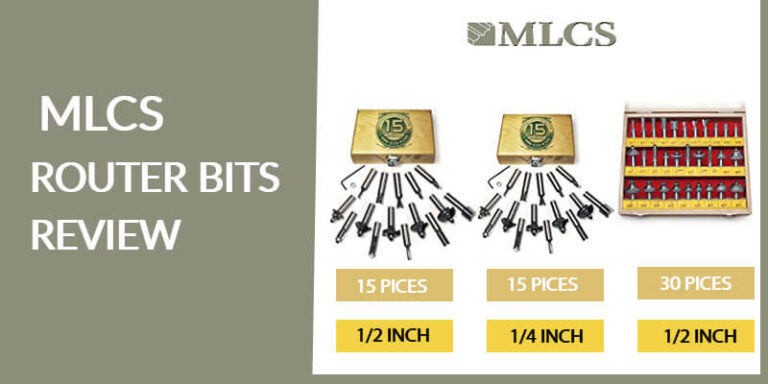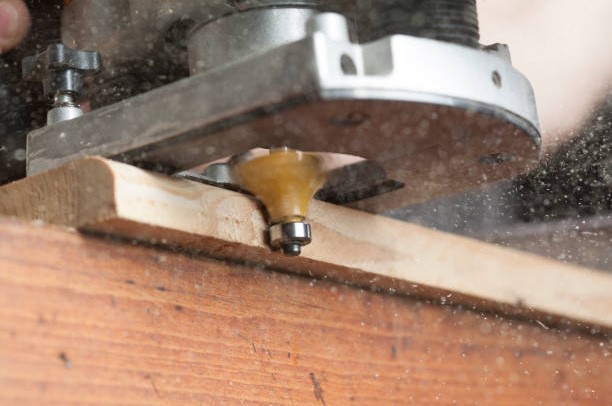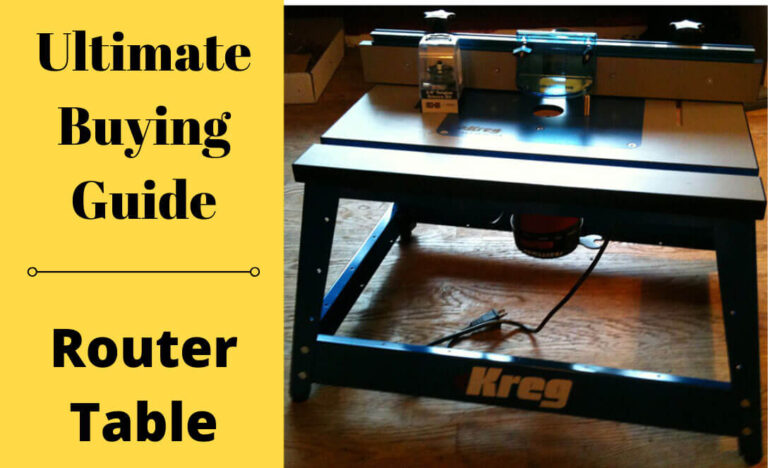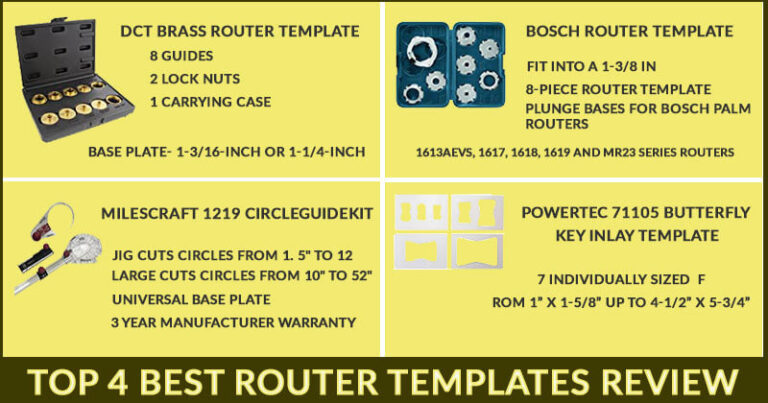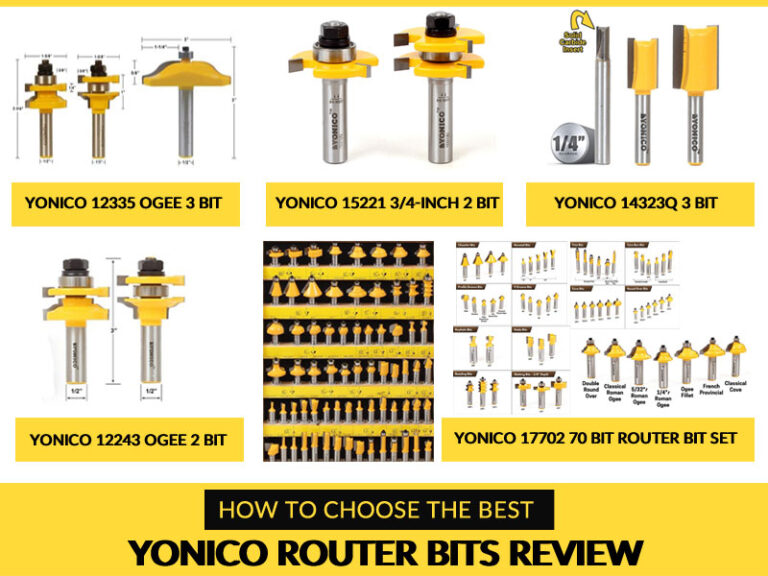Best Plunge Router: Top 5 Picks for Woodworking Projects
There are various kinds of tools available for woodworking. Whether you do it as a hobby or as a professional job, you do have plenty of knowledge regarding them.
Hence, you already have ample idea about how handy plunge routers can be.
Although, even if you don’t, it’s okay. We are here to provide you with everything that you need to know about them.
In this guide, you will have access to information that will help you find the best plunge router for you. With multiple options out there, you don’t have to be confused anymore.
You are just a few words away from purchasing the right tool.
5 Best Plunge Router Reviews
Tons of routers are claimed to be the best one on the internet. Hence, it becomes quite hard to select the right instrument for your task; we get it. That is why we are providing accurate information regarding these tools to make choosing the best plunge router for woodworking easier for you.
1. Bosch 1617EVSPK Wood Router Tool Combo Kit
Here’s a product that will be useful to you for multiple purposes. Whether you feel like cutting dovetails or forming edges, it will be a suitable tool to utilize nevertheless. With top-notch practicality and durability, you will never find anything else that will be able to take its place.
Speaking of durability, this tool can last long enough to accompany you for years. It is built using aluminum, which is known to be sturdy and lightweight at the same time. On the other hand, the fixed base comes with wooden handles, whereas the plunge base includes the ergonomic ones.
Both will provide comfort with strength. We talk about how most tools are easy to use, but this one surpasses others in this sector. For instance, its handles will let users have more control over it. Hence, you will find shaping and cutting objects more pleasant.
On the other hand, it sustains constant speed throughout the entire time, producing more precise results. If you think this tool isn’t diverse enough for you, then think again. It can be used for several tasks.
Starting from plunging to slot cutting, this knows how to get things done accurately. Moreover, the kit contains extras that make these tasks effortless. The handgrip provided is loosely bound with it.
You may need to tighten them from time to time, which will be a little unpleasant. Moreover, to plunge with accuracy, you will have to lean into the tool to move it accurately. This could cause safety issues.
- Constructed using aluminum
- Wooden and ergonomic handles provided
- Handles designed for more control over them
- Sustains the same speed throughout the entire process
- It can be used for diverse tasks
- Loose handgrips
- Safety issues because of the plunging base
2. DEWALT Router Fixed/Plunge Base Kit
Here’s an equipment that is not only powerful but is also very friendly to use. With its unique features, you will start considering woodcutting as more of a hobby than a stressful job. Hence, don’t miss out on this amazing product that is made to exceed expectations.
First of all, this handy tool collects dust through the column. A lot of its competitors don’t include this feature. Hence it becomes hard to view the indent line. Fortunately, that’s not a problem you will be facing. About 95% of the dust will be collected to ensure more accuracy in your project.
You will easily be able to alter the depth of your cuts with its adjustment ring. This tool lets you make modifications vertically, with 1/64 inch augmentation. On the other hand, you can vary the speed of the router for optimum results. You can choose from a range of 8000-24000 RPM for multiple applications and such.
Its 12-amp motor not only makes it a powerful tool but also a reliable one. And it is suitable for various phases of woodcutting; so, you will never have to turn to other equipment. More importantly, it is durable and consistent. It is built using hard-wearing metal and brass, which can withstand tremendous pressure.
No matter how durable the router itself is, the motor seems to have a short life span. In some cases, it starts smelling after some sessions and then stops working. On the other hand, the variable speed control feature may stop serving you after months of usage. If that doesn’t happen, then this tool will be a great one to own.
- Collects 95% of dust through the column
- Easy modification of depth
- Let’s you control the speed
- Heavy-duty metal construction
- Multi-functional
- The motor is short-lasting
- Variable speed feature may fail
3. Triton TRA001 3-1/4 HP Dual Mode Precision Plunge Router
While woodcutting is fun, it can also be a little dangerous if your equipment doesn’t provide enough safety. Therefore, it’s necessary to find a tool that offers both precision and security. That is why this tool has been manufactured with both the features (and much more) for the best experience.
If you want to get through the toughest of woods, then this is the perfect tool for you. With a 15 amp and 3.25 horsepower motor, you will never find any material too strong for it. But don’t worry, it won’t hit the object with all of its power right at the start.
It will begin with a soft cut, which will save you from trouble due to build-up torque. Most importantly, you get to have full control over how the object operates. You can increase and decrease the speed, or keep it constant to provide the perfect slashes.
On the other hand, you can also adjust how deeply it cuts. With its micro winder, altering the depth continuously becomes a piece of cake. Its rack and pinion system lets you switch from the plunge mode to the fixed base router. Hence, you can effortlessly get access to the best of both.
To make it better, it comes with air vents on the side, which gets rid of most of the dust. This makes your work error-free.
However, this router comes with some plastic parts inside of it. This significantly reduces its sturdiness and makes it more prone to breaking down. Moreover, its knobs and screws may fall off after a few uses, so you may need to fix them from time to time.
- 15 amp and 3.25 horsepower motor
- Begins with a soft cut to avoid build-up of torque
- Micro-adjustable winder
- Full control over the speed
- Rack and pinion system
- Includes some plastic parts
- Screws and knobs fall off
4. Plunge Router Electric Brake
It’s only normal for you to want something worth every penny of your investment. That is why this tool offers top-notch accuracy at the best value. You will only regret not getting it earlier. So, take a look at what should be addressed as the best plunge router for the money.
We can’t stress enough on how effortless executing your jobs will be with this tool. It includes a variety of features that will contribute to giving you a better experience. Such as, for greater control, you get two built-in switches on the ergonomic soft-grip handles.
Hence, you will be comfortable as well when using it. On the other hand, to increase visibility even in dark areas, two LED lights are fitted in it. This ensures that you will never go wrong when routing. Moreover, with its shaft lock, you can conveniently change the bit whenever necessary.
Also, it can be used for continuous operation, thanks to its lock-on system. But that’s not all. This tool, as the best budget plunge router, offers more power than most of its competitors. It comes with a 15 amp motor, which can withstand work speed from 9,000 to 22,000 RPM.
You can change the speed for extra stability when operating it. Furthermore, its construction ensures a long lifespan. The lock switch included in it is quite stiff. So, it cannot be moved swiftly when working with the tool.
Furthermore, you will have to pull it back towards you. Also, this equipment does not come with an edge guide.
- Ergonomic soft-grip handles
- Two LED lights are fitted in it
- Effortlessly change bits with shaft lock
- Variable speed from 9000 to 22000 RPM
- Sturdy construction
- Stiff lock switch
- Does not include an edge guide
5. Festool 574692 OF 1400 EQ Router
You may think that this equipment looks great, but that’s not its only great feature – it works even better. For those who want a compact yet 100% precise router, they can’t possibly stumble across a perfect tool than this.
There’s a reason why you can cut with the utmost accuracy using this. First of all, its dust extraction ports collect dust and other particles on your project. This lets you view the cut line more clearly; hence, allowing you to plunge with complete accuracy. For added comfort and operation time, it includes an ergonomic handle.
As a result, you will get exhausted less often when using it, and have complete dominance over it. Switches are fitted into the equipment, allowing you to operate it with only one hand. Moreover, its spindle lock lets you change bits quite effortlessly.
The depth can be adjusted to the smallest of values with this tool. Around 1/256-inch of depth can be controlled with ball detents. This makes your routing extra precise. On the other hand, its electronic controls offer stable speed even under heavy pressure.
Hence, the tool will stay protected, even under extra load and heat. The price is a little higher compared to its other counterparts. This may be a little unpleasant to the ones looking for a piece of equipment on a budget.
Moreover, when using this tool under pressure, noises and sparks may come out of the housing. This may give rise to safety issues.
- Dust and debris extraction
- Ergonomic handle with switches fitted into it
- Can effortlessly change bits
- Depth can be controlled up to 1/256 inch
- Stable speed even under high pressure
- High priced
- Noises and sparks may come out of the housing when under pressure
Things to Consider Before Buying
You may need a plunge router for professional reasons or simple housework. Nevertheless, you must keep some of the key characteristics in mind.
The significance of those features depends on what you need the equipment for. So, for your ease of understanding, we will focus on both professional and home-use sides.
Motor Power
One of the essential aspects of any equipment is the power that it can generate. Plunge routers are powerful enough, but still, some are more robust than others. Hence it is important to check the specifications thoroughly and make sure that it matches your needs.
Current
There are two details to look for- the first would be current, and the other is horsepower. Most of these tools have at least 10-15 Amp of current. The ones on the lower side of the range are not as strong as the ones on the higher side. Although to be on the higher side, you will need to pay more bucks.
Horsepower
As for horsepower, most routers come with a horsepower of 2, or somewhere around this range. It is recommended not to go any lower. Or else, even for light materials, your equipment will not generate enough power.
For Professionals
It is recommended you go for the highest values of horsepower and current you get your hands on. Mostly because you will need it for diverse applications, and with little power, you can’t achieve that.
For Home-Users
You know what you need your equipment for. Hence, it’s recommended you purchase according to that. There is no point in spending money on advanced features if they are of no use to you.
Variable Speed Controller
This is one key feature for anyone using a plunge router. Without any control over the speed of your equipment, you won’t be able to control the cuts on it. Generally, the speed will remain constant. But you should be able to increase or decrease it according to your woodworking needs.
For Professionals
It is a must. You should go for one that offers modification of speed from at least 8,000 to 24,000 RPM. Otherwise, it will be very difficult for you to use your tool for multiple purposes.
For Home-Users
It depends. If you think the tool is already providing the speed that you need, then there’s no need to look for this feature specifically.
Life Span
Of course, an equipment’s durability determines half of its worth. People usually avoid products that are not going to last for a considerable amount of time. But for that, you need to look into some features that will let you know about the life span of the tool.
Construction Material
The construction material has more significance than you would think. If it’s made of plastic, then there’s a high possibility of it breaking down after a few uses. Hence, it’s necessary you choose heavy-duty metal while making sure that it is rust-resistant.
The Material of the Screws and Knobs
On the other hand, you also need to keep an eye on the materials of the screws and knobs and how they are attached to it. Again, plastic should be avoided. Also, when handling the product, check how tightened the screws are.
For Professionals
The sturdiest tools are necessary. You wouldn’t want your router to break down while you are in the middle of a project. That will only prolong the delivery of your workpiece. Surely, you wouldn’t want to displease your customers.
For Home-Users
Don’t spend extra bucks on an unnecessarily heavy-duty tool. You will only be using it a few times throughout an entire year. So, it’s unlikely for even light equipment to break down after a few uses.
Comfortable Usage
It is a characteristic more or less anyone would look for in a tool. Many features make equipment easy to use.
Ergonomic Handles
This keeps you fatigue-free, enabling long hours of work.
Weight of Product
On the other hand, the weight of the product matters as well. Powerful routers are mostly heavy, and they won’t be convenient to work with unless you have the right setting. Hence, it’s important to consider the weight before making the purchase.
Additional Features
Multiple traits aren’t available in some routers but are integrated into others. They will make your woodworking experience much better. Hence, you should look for these before you choose a router.
Soft Starts
Plunge routers must have soft starts. Here’s why- when you set a speed and start your equipment, it may have some torque built up due to resting for quite a while.
This may catch you off guard when you are starting the tool. So, soft starts, make sure that doesn’t happen. Once you power it, you will experience a pause with the router accelerating gently to the desired speed.
Depth Adjustment Ring
The depth adjustment ring lets you add precision to your work. Look for the ones that will let you modify within at least 1/64 to 1/256 inch.
Collet Size
Some routers include diameter bits of ½ inch, while others include ¼ inch. They can even include both. These collet sizes let you change the bits efficiently while providing stability.
LED Lights
LED lights are rarely fitted in these tools. But if they are, by any chance, then your visibility will increase a lot during work. You will be able to work even under low light. If this feature is integrated into your tool, then the number of lights included are usually two.
Some also come with buttons to increase or decrease the intensity of light. Overall, it’s very useful.
Vacuum Ports for Dust Extraction
Speaking of visibility, routers with vacuum ports for dust extraction are also a savior. Excessive dust or debris won’t lie at the top of your workpiece, letting you view your line of cut. Moreover, this also makes cleaning up after work much easier. Truly a feature you don’t want to miss out on.
Safety Features
Lastly, make sure the tool includes safety switches and such. Woodworking itself isn’t the safest job. Hence, it’s always better to be extra careful.
Frequently Asked Questions
Below are some of the most commonly asked queries regarding plunge routers:
- What is a plunge router used for?
Their basic job is woodwork. If we are to get into details, then it is used for template routing, making joints, cutting mortises, and many more. If you have a specific task in mind, then you can check whether the plunge router can be used for that or not.
- A plunge router allows for precise and controlled routing of grooves and dadoes in wood. This is useful for creating channels to fit shelves, dividers, or other components in cabinetry or furniture-making.
- Plunge routers are commonly used to create mortises, which are rectangular recesses in wood for joinery purposes. Mortises are often used for fitting tenons or other woodworking joints, and a plunge router enables the accurate and efficient creation of these recesses.
- Inlays are decorative elements that are fitted into a recess in a workpiece. Plunge routers can be used to cut precise recesses for inlays, allowing for intricate and detailed designs to be incorporated into woodworking projects.
- With the appropriate router bit, a plunge router can shape the edges of the wood, such as adding decorative profiles like chamfers, round-overs, or ogees. The plunge feature allows for controlled cuts and smooth transitions along the edges.
- Plunge routers are often used with templates or guides to achieve consistent and accurate cuts. The plunge mechanism allows the router bit to be lowered into the workpiece at any point, making it suitable for following templates and creating duplicate shapes or patterns.
- Although primarily designed for plunge cuts, some plunge routers can be used for surface planing or flattening uneven or rough wood surfaces. This can be helpful for leveling tabletops, slabs, or other large wood pieces.
- While trim routers are more commonly used for this task, plunge routers can also be used to trim laminate edges flush with the underlying substrate. They provide stability and control for achieving clean and precise trimming results.
- Does every plunge router come with a variable speed controller?
No, not every plunge router comes with a variable speed controller. The availability of a variable speed controller depends on the specific model and brand of the plunge router. While many modern plunge routers do offer variable speed control, some entry-level or basic models may only have a single speed setting.
Variable speed control allows the user to adjust the rotational speed of the router bit. This feature is particularly useful when working with different materials, router bit sizes, or specific routing tasks. Lower speeds are generally preferred for larger router bits or when working with harder materials, while higher speeds are suitable for smaller bits or softer materials.
If variable speed control is an important factor for your woodworking needs, it is recommended to check the specifications or product descriptions of the plunge router models you are considering to ensure that they offer this feature.
- How does a plunge router work?
- Before starting the router, you need to set the desired cutting depth. Most plunge routers have a depth adjustment mechanism, such as a depth stop rod or a depth turret, which allows you to select and lock in the desired depth.
- Place the base of the plunge router on the surface of the workpiece, ensuring that the router bit is clear of the material.
- Turn on the router using the power switch or trigger, depending on the model. The router will start running at the selected speed if it has a variable speed control feature.
- Grip the handles of the plunge router firmly and engage the plunge mechanism. Depending on the design of the router, this may involve releasing a lock, pulling a plunge lever, or pressing down on the handles. As you apply downward pressure, the router bit will start to penetrate the workpiece.
- Once the router bit is engaged with the material, you can guide the router along the desired path. Move the router steadily and smoothly, following the intended cutting line or using a template or guide if necessary. The depth of the cut can be adjusted by controlling the plunge depth and the speed at which you move the router.
- Once you have reached the desired depth or completed the cut, release the plunge mechanism and slowly lift the router bit out of the material. Ensure that the router bit is clear of the workpiece before turning off the router.
- How should a plunge router be moved?
- Position the plunge router firmly on the surface of the workpiece before activating the router. Ensure that the base of the router is fully supported and stable.
- Before making the plunge cut, plan the path you want the router to follow. This can be a straight line, a curved path, or along the edge of a template or guide. It’s helpful to mark the cutting line on the workpiece to serve as a visual reference.
- Depending on the design of the plunge router, engage the plunge mechanism by releasing a lock, pulling a plunge lever, or pressing down on the handles. This will lower the router bit into the material.
- Move the router at a steady and controlled speed, neither too fast nor too slow. Moving too quickly may result in a rough or uneven cut while moving too slowly can cause burning or excessive material removal.
- Apply consistent downward pressure on the handles of the plunge router while moving it along the intended path. This helps maintain stability and ensures a smooth cut. Avoid pushing or pulling unevenly, as it can cause the router to veer off the desired cutting line.
- Keep your eyes focused on the cutting line or follow the edge of a template or guide. This will help you maintain accuracy and stay on track. Use both hands to control the router and keep it steady during the cut.
- Once the cut is complete or you have reached the desired depth, release the plunge mechanism and slowly lift the router out of the material. Ensure that the router bit is clear of the workpiece before turning off the router.
- When it comes to a routing table, would a fixed base router be better or a plunge one?
When using a plunge router, it is important to move the tool in a controlled and deliberate manner to achieve accurate and clean cuts. Here are some guidelines for moving a plunge router:
- Position the plunge router firmly on the surface of the workpiece before activating the router. Ensure that the base of the router is fully supported and stable.
- Before making the plunge cut, plan the path you want the router to follow. This can be a straight line, a curved path, or along the edge of a template or guide. It’s helpful to mark the cutting line on the workpiece to serve as a visual reference.
- Depending on the design of the plunge router, engage the plunge mechanism by releasing a lock, pulling a plunge lever, or pressing down on the handles. This will lower the router bit into the material.
- Move the router at a steady and controlled speed, neither too fast nor too slow. Moving too quickly may result in a rough or uneven cut while moving too slowly can cause burning or excessive material removal.
- Apply consistent downward pressure on the handles of the plunge router while moving it along the intended path. This helps maintain stability and ensures a smooth cut. Avoid pushing or pulling unevenly, as it can cause the router to veer off the desired cutting line.
- Keep your eyes focused on the cutting line or follow the edge of a template or guide. This will help you maintain accuracy and stay on track. Use both hands to control the router and keep it steady during the cut.
- Once the cut is complete or you have reached the desired depth, release the plunge mechanism and slowly lift the router out of the material. Ensure that the router bit is clear of the workpiece before turning off the router.
Final Words
Before thinking about getting one of these tools, you need to think about whether you need it or not. While they can be used for a lot of tasks, it is still better to make sure the purchase would be worth it. And to make it more worth it, have patience and pick the best plunge router for yourself.
Table of Contents














